Question and Answer – May 2011
Each month, Neil chooses 5 to 7 questions of the greatest general reader interest and answers them here in e-gardens. Note that he requires photos for this visual medium. If you don’t have a photo, he invites you to call his radio programs. For the best possible answer, he also needs to know the city in which you’re gardening. Click here to send him your photo and question.
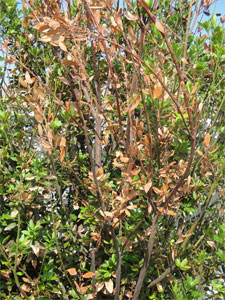
Question: We planted a bay laurel in front of our house about 7 years ago. It had done well until this past winter. Now, about 30 percent of the plant is browned. Should it be pruned severely and allowed to start over, or will it recover? P.W., no city given.
Answer: If ever there were a question where I need to know your home city, this is it. Bay laurels (Laurus nobilis) are outdoor trees, but they’re only winter hardy from Zone 8B and southward. Some sources even list it as hardy only in Zones 9 and 10. What you’re seeing is freeze damage, and it’s likely to recur if you live toward the north end of Zone 8, and certainly if you’re in Zone 7. (Here is a link to the official map. Click on it to find your exact area.) Prune as needed to restore its good shape. Make provision to cover it the next time an extreme winter cold snap threatens it.
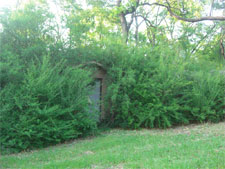
Question: How can I get rid of acres and acres of invading privet? It’s everywhere! M.W., East Fort Worth.
Answer: This is a horrible invasion, and as long as there are plantings like this nearby, birds will keep planting the seeds for you. The best way to begin is by brush-hogging it down to the ground. Shred it now, before this year’s seed crop develops. Keep mowing to prevent regrowth and it will eventually give up. You can use a broadleafed weedkiller containing 2,4-D to eliminate the smaller plants, but read and follow label directions carefully to avoid doing damage to desirable trees and shrubs that are nearby. It will take time to clear the area, but you’ll see progress as you continue.
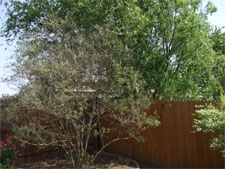
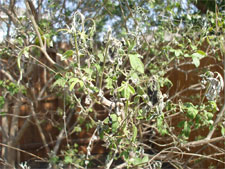
Question: I planted this vitex in the spring 2008. It flourished until spring 2010, when I noticed the leaves were dying shortly after they sprouted. My speculations are it is either losing out in competition with my neighbor’s tree, or it is getting runoff from my neighbor’s salt water pool. Our other vitex is flourishing with no problems. What can I do to help it thrive again? L., Denton.
Answer: The shading from the overbearing tree next door can’t be doing it any favors, but the fact that the new growth was wilted when you took the photo really leads me to think that salt damage may be involved. Whatever the cause, my bet is that you’ll have to switch over to some other kind of plant in that area. You might be able to have the soil tested for salinity residues and tell if the salt was at fault. Is there a way to put some kind of drain system near the property line so that runoff saltwater could be discharged into the storm sewers instead of across your landscape? This might be a good time to hire a landscape contractor to work on-site to see what options you have.
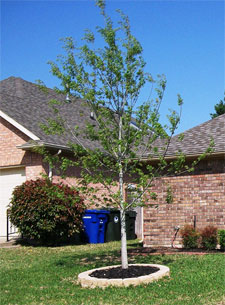
Question: I planted this red oak last November. As I dug its hole, I hit solid shale at 10 inches. I built a raised bed around it. Is there anything to be concerned about or do differently (irrigation, fertilization, etc.) with the tree basically "sitting" on shale? D., Carrollton.
Answer: Some people, especially in Southeast Texas (where water tables tend to be higher) prefer to plant their trees "high" regardless of whether there is bedrock near the soil surface or not. I must confess that planting above grade in North Texas always scares me, because the roots will begin their lives above soil line and only grow farther out of the soil with age. If that’s not a concern to you, you’re good to go. Fortunately, Shumard and Texas red oak trees can handle alkaline shale soils. You’ll have to water and fertilize it much more often, less at a time due to its limited soil reservoir, but it will grow and develop into a very large tree. Had it been my tree to plant, I probably would have started with a smaller one and planted it closer to the surrounding grade. But, that’s just one guy’s opinion.
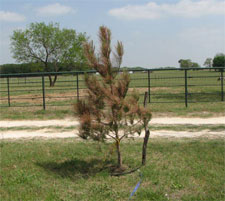
Question: We planted three loblolly pines in front of our place in southern Hill County a little over a year ago. Our ranch is part of an old peanut farm with very sandy soil. One of the pine trees is doing great, the other two have turned brown on top of the pine needles, with the lower parts of the needles still green. They are watered by a drip system, but they still seem to be faltering. We have provided them with iron and fertilizer but nothing we do helps. Advice? D. and C., Southern Hill County.
Answer: This isn’t iron deficiency. In fact, I really don’t think it’s nutrient deficiency at all. It looks like moisture stress, and all I can do is guess at the cause. It might have gotten too dry sometime in the summer, or even fall or winter. It might have been burned by the ice and cold of January. If any salt was used nearby to melt ice, or if the drip system is using water that might have a high sodium content, either of those could contribute. Sorry not to be more definitive, but pinning down reasons for symptoms of moisture stress can be very difficult.
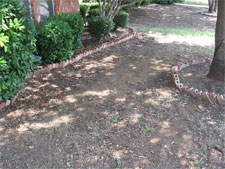
Question: I am having huge problems with my bermudagrass. People are always walking in between my house and my neighbor’s, and it appears I have a bad infestation of grubs. Do I need to buy sod and start all over, or is there a seed of some sort that I can plant to get new grass to grow? Also, I bought grub killer, but I wonder if it will be effective if I just spread it on the dirt? J..P., no city given.
Answer: This is not a problem with grub worms! Absolutely not a problem with grub worms! It doesn’t even appear to be primarily due to foot traffic. I think it’s 100 percent related to shade. Bermudagrass needs 6 to 8 hours of sunlight daily to thrive. At less than 6 hours, it fades away, especially with any traffic at all. Even St. Augustine would probably falter in these conditions. I have areas in my landscape that look just like this, and I’ve used finely ground pine bark mulch as my pathways. I’ve been very satisfied with the results. Sure, a little of it washes during heavy rains, but it’s easy to rake back in, or even to replace it. Pavers or angular gravel that would lie flat are other options. You just need to reset your focus on shade landscaping.
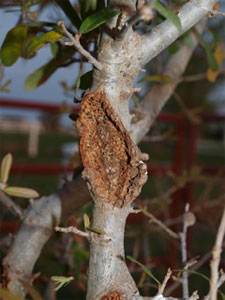
Question: I have a new live oak that has these disruptions in its branches. What causes this, and what can I do about it? S., no city given.
Answer: I have seen this damage every once in a while, and I was never sure what caused it. I sent it to my tree expert buddies at Arborilogical Services (www.arborilogical.com), and they must have had a staff meeting about it. The consensus opinion of four of their outstanding arborists is that this is damage done by apple tree borers. Owner Steve Houser wrote back, “They seem to create a wound that does not heal (or compartmentalize) for a number of years.” Russell Peters, a recent Texas Arborist of the Year, wrote that “Management is to prune out the affected limbs. Usually not a persistent problem.” I would add that it never hurts to get a certified arborist on the job, and in thanks for their work in helping me, I’ll tell you that Arborilogical Services has 10 such certified arborists. Thanks, guys!

